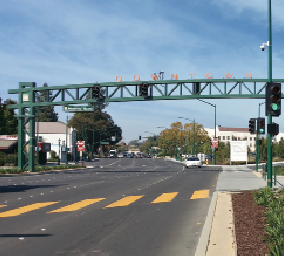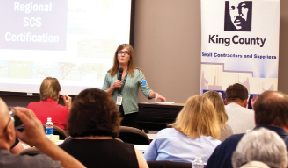Corridor Improvement
Hayward, Calif.
Hayward, Calif.’s Route 238 Corridor Improvement Project is the largest public works initiative in the city’s history, totaling $105 million in costs to improve regional mobility. The project extends over five miles within the city, transforming a congested and sparse road into a landscaped corridor used by pedestrians, bicyclists, transit, trucks and cars. The project took three years to complete and became fully operational in June 2013.
“This effort was so much more than a transportation plan,” Project Manager Kevin Briggs says. “It was a major step toward revitalizing our historic downtown and modernizing the corridor. Our holistic approach allowed us to balance the needs of motorists, pedestrians, bicyclists, the disadvantaged and the environment while laying the groundwork for future economic development.”
For more than 40 years, Route 238 was a constant source of frustration to residents and businesses needing access to community facilities, transportation hubs and educational institutions. In 2003, the city began working closely with agencies such as Caltrans, Alameda CTC and Alameda County to improve the commuter corridor. The majority of the project was funded through a half-cent sales tax allocated by the Alameda County Transit Authority.
One of the project’s major components designed to relieve traffic congestion and improve flow is a downtown mini-loop — a multi-lane one-way loop that spans the corridor. The corridor was also widened to relieve a major bottleneck and provide access to the California State University campus. It includes significant pedestrian and bicycle improvements such as sidewalk construction along the entire length of the corridor and a bike lane.
New adaptive traffic controls at 28 intersections along the corridor keep traffic flowing when there is no cross traffic and will be monitored in a new traffic management center. Several gateway park features were constructed at major intersections to mark the downtown entrance, and customized railings between roadways, bicycle racks and directional signs add to traveler convenience. The project also saw the installation of more than 1,000 LED streetlights with dimming controls that save energy.
“The tangible benefits – reduced traffic, safer streets, improved infrastructure – are self-evident. With a project of this size and scope, we’ve really been able to prove what our city is capable of achieving,” Briggs says. “This project has also set the table for a resurgent downtown and an influx of new businesses, events and activity. The community is genuinely excited now about what’s coming next.”
_______________
 Procurement Reform
Procurement Reform
King County Government, Wash.
With a population of 2 million and an annual budget of $5.3 billion, Seattle, Wash.’s King County has generated some major business over the years; however during his 2009 campaign for County Executive, Dow Constantine received consistent feedback from small, local business owners that the inefficient nature of the county’s procurement processes inhibited applications for government contracts. In March 2010, Constantine launched a countywide Procurement Reform Initiative aimed at reducing the cycle time and associated costs of procurement processes and increasing contracting opportunities for small and disadvantaged firms.
“The efficiency and equity results of the Procurement Reform Initiative provide the community with tangible examples of how King County is committed to its vision of ‘a diverse and dynamic community with a healthy economy and environment, where all people and businesses have the opportunity to thrive’,” says Sandy Hanks of King County Finance and Business Operations.
An executive-level Steering Committee and Procurement Reform Work Group with members from each county department guided the initiative. After a two-year effort with a budget total of $330,000, the goal to raise procurement performance was met, and the King County Government was transformed.
The county has streamlined standard contracts and online vendor registration, reduced cycle times on design and construction contracts and launched a small business accelerator program to ensure the participation of small firms in technical service contracts. Every quarter, the county issues a report summarizing the reform’s actions and metrics. In Q3 of 2013, King County saw processing time reduced by 50 percent for design and construction contracts and a 90 percent increase in construction contracts awarded to small contractor and supplier firms. The county also reduced staff costs by $92,000 by using streamlined job orders and larger work order contracts.
The county has further enhanced its efficiency through technological updates that included replacing the Department of Assessments’ Tablet PCs used to collect and analyze property characteristics data with iPads that are faster and have cellular and Wi-Fi capabilities. The switch reduced hardware replacement costs by $400,000, and those savings were used to develop a new software application for property appraising called iRealProperty. The new app allows the DOA to collect more accurate and robust data from the field, which is error-proofed at the point of input.
“By listening to our employees, eliminating waste, and constantly experimenting to find better ways to work, we deliver better results for the communities we serve,” Hanks says.















